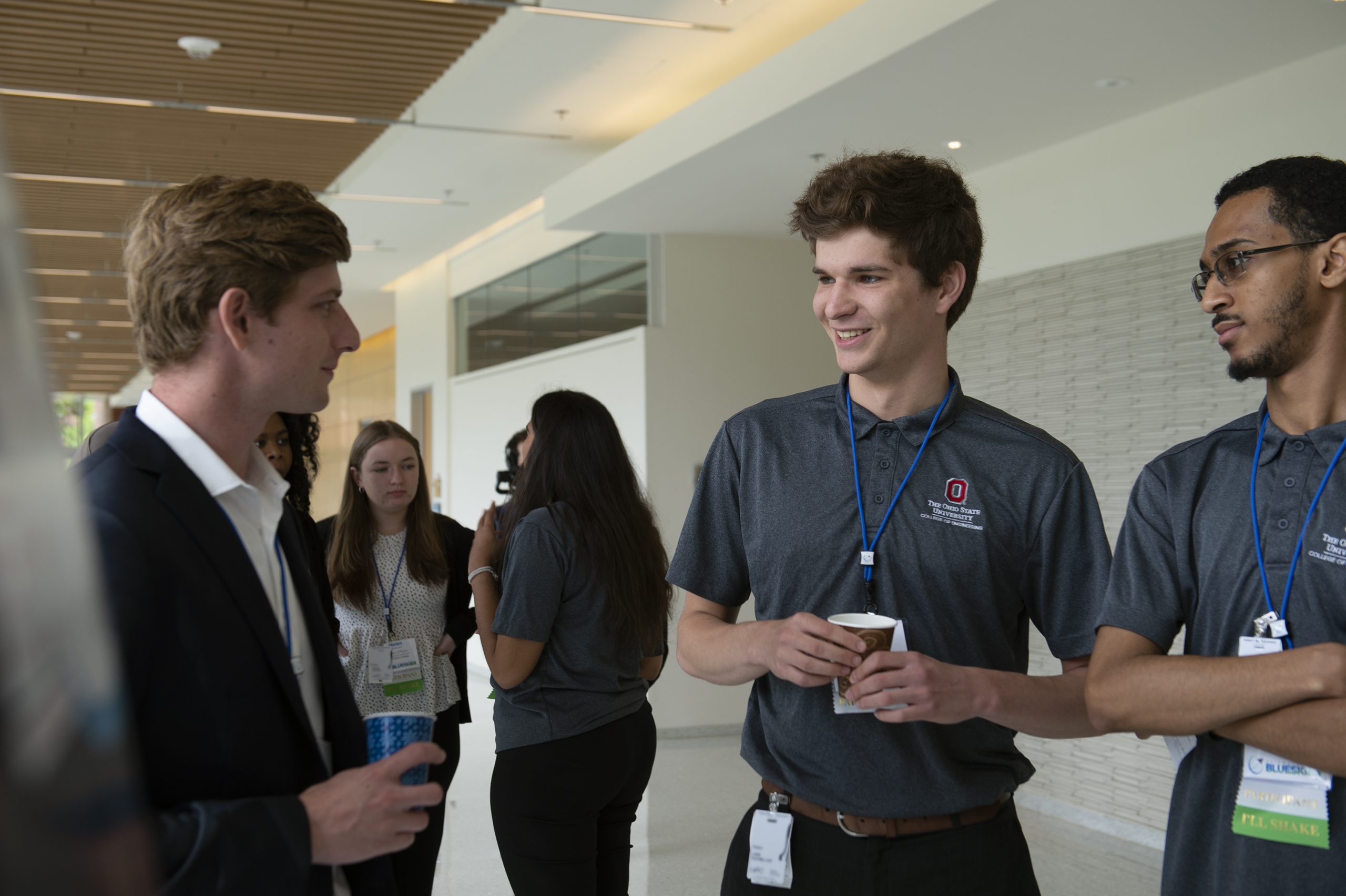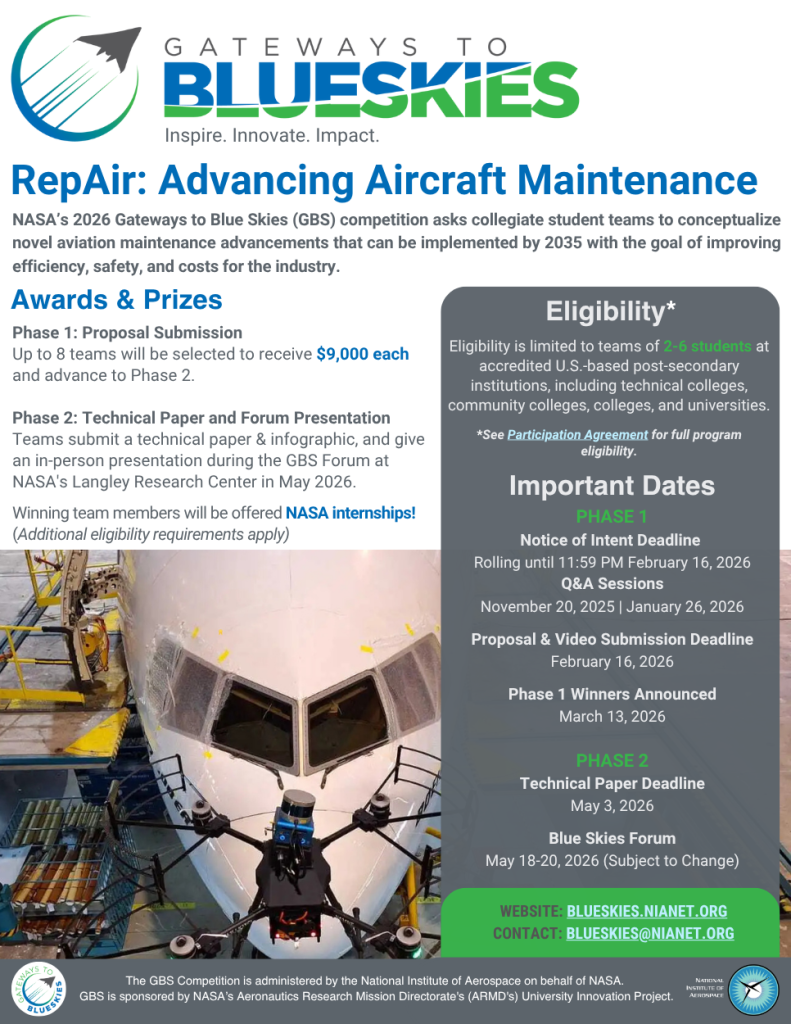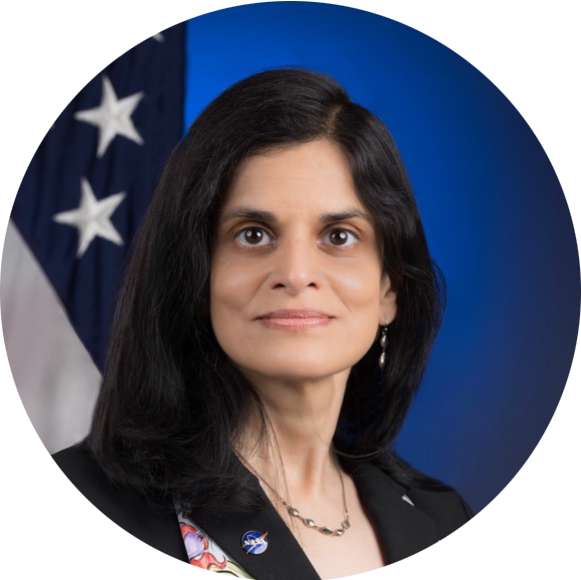Competition
RepAir: Advancing Aircraft Maintenance
2026 THEME OVERVIEW
The commercial aviation industry is a crucial component of the U.S. economy, playing a vital role in transporting people, intermediate/final goods, and driving demand for various goods and services nationwide. This network enhances the quality of life for the whole country and facilitates business interactions within and globally, boosting productivity and prosperity. However, the industry faces numerous challenges, particularly the need to reduce rising operational costs in a growing market to accommodate increased demand in air travel, e-commerce, and cargo sectors. Issues such as aging aircraft and components, technological advancements, and staffing shortages further complicate these challenges, hindering efforts to balance passenger safety with operational efficiency. To address these challenges, the industry needs to swiftly innovate and implement more efficient and resilient aircraft maintenance practices, including the adoption of new technologies.
In the 2026 Gateways to Blue Skies Competition, teams will conceptualize novel aviation maintenance advancements that can be implemented by 2035 or sooner with the goal of improving efficiency, safety, and/or costs for the industry. Teams are encouraged to consider high-potential technologies and systems that aren’t currently mainstream or highly regarded as becoming mainstream in the future, imagining beyond the status quo.
NASA Aeronautics is dedicated to working with commercial, industry, and government partners in advancing the capabilities and performance of the U.S. sector. Capabilities and opportunities for improvement include, but are not limited to:
- Aging aircraft and component wear
- Advanced monitoring and diagnostic systems
- 3D printing for replacement parts
- Upgrading systems and components (aircraft)
- Lifecycle management
- Advanced data analytics
- Automated compliance checks (regulatory)(aircraft)
- Predictive maintenance technologies
- Advanced inventory management systems
Initial participation involves a conceptual study, submission of a 5-7 page proposal, and creation of a 2-minute video summarizing the team’s proposal. Based on the review of proposal submissions, up to 8 teams may be selected to receive a $9,000 prize and advance to Phase 2, which includes a final design review at the GBS Forum at NASA’s Langley Research Center. Internship opportunities with NASA’s ARMD serve as the competition prize for members from the winning team. * This is abbreviated theme language, please see the 2026 Competition Guidelines document for full details, requirements, and guidelines.


NASA’s Aeronautics Research Mission Directorate (ARMD) conducts research that generates concepts, tools, and technologies to enable advances in our Nation’s aviation future. ARMD programs facilitate a safer, more environmentally friendly, and efficient national air transportation system.
As a program within NASA ARMD, the University Innovation Project (UI) funds post-secondary-led innovation to address system-level challenges in NASA Aeronautics’ strategic plan, which guides the Aeronautics programs. This is done through NASA-complementary, independent, alternative, and multidisciplinary research. The main UI research opportunities include the University Leadership Initiative (ULI), the University Student Research Challenge (USRC), and NASA’s Gateway to Blue Skies Competition (GBS).
GBS expands engagement between post-secondary institutions and NASA Aeronautics, industry, and government partners by providing an opportunity for multidisciplinary teams of students from all academic levels (i.e., freshman, sophomore, junior, senior, and graduate) and fields to tackle critical challenges and opportunities within the aviation industry through a new project theme each year. The competition is guided by a push toward new technologies and fostering forward-looking, socially responsible aviation.
Phase 1 Submissions
NOTE: Be sure all submissions adhere to Competition Guidelines requirements and that all team members read and agree to the *NEW Participation Agreement
Dates & Deadlines
All deadlines are at 11:59 PM Eastern Time unless otherwise indicated.
| Date | Description |
|---|---|
| Rolling (Previously November 4, 2025) | Notifications of Intent (NOI) Submission Deadline Submit an NOI |
| November 9, 2025 | Deadline to Submit a Question in Advance Submit a Question |
| November 20, 2025 3:30 - 5:00 PM Eastern | Q&A Session #1 for Interested Teams Join the Q&A Session |
| January 27, 2026 3:30-4:30 PM Eastern | Q&A Session #2 for Interested Teams Join the Q&A Session |
Phase 1: Proposal and Video Submission
| Date | Description |
|---|---|
| February 16, 2026 | Deadline to Submit Proposals and Videos Submit a Proposal |
| March 13, 2026 | Teams are notified of their selection status |
Phase 2: Final Deliverables and Forum
| Date | Description |
|---|---|
| April 17, 2026 | Deadline to Register and Pay for the GBS Forum |
| May 3, 2026 | Deadline to Submit Final Paper and Infographic |
| May 15, 2026 12:00 PM Eastern | Deadline to Submit Presentation Files |
| May 18-20, 2026 | Tentative Date for 2026 GBS Forum at NASA Langley |
Resources
- NASA Acres
- NASA Harvest
- NASA Land Cover Land Use Change
- NASA Earth Science Applied Sciences Agriculture Program
- NASA GISS AgMIP
- OpenET
- System-Wide Safety Project (SWS)
- USDA/National Institute of Food & Agriculture
- USDA/Agricultural Research Service
- Environmental Protection Agency (EPA) – Agriculture and Air Quality
- Farmer’s Market Coalition
- Department of Health & Human Services (DHHS) – Food Insecurity
- Global Alliance for the Future of Food
- UW Libraries: STEM Databases
- Spinoff: Field-Scanning Drone Gives Farmers Better Data
- NASA Open Source
- NASA Technical Report Server
- FAA UAV/UAS and Airborne Capabilities & Regulations (sources vary)
Logos/Usage Guidelines








 Dan Martin
Dan Martin Cordelia Hiers-Brady
Cordelia Hiers-Brady Shawn Engelland
Shawn Engelland George Burba
George Burba CJ Bixby
CJ Bixby
 Jay Stalnacker
Jay Stalnacker Charles Sheehe
Charles Sheehe Travis Potter
Travis Potter Amy McCluskey
Amy McCluskey Dr. Shanna McClain
Dr. Shanna McClain Peggy Cornell
Peggy Cornell Matthew Boucher
Matthew Boucher Susan Bayley
Susan Bayley Dr. Marcus Johnson
Dr. Marcus Johnson Genevieve Ebarle
Genevieve Ebarle Stacy Dees
Stacy Dees Shelley Spears
Shelley Spears Janice Kurbjun Miller
Janice Kurbjun Miller Mina Cappuccio
Mina Cappuccio Craig Nickol
Craig Nickol Jeanne Yu
Jeanne Yu Devin Pugh-Thomas
Devin Pugh-Thomas Mani Gavvalapalli
Mani Gavvalapalli Phil Kenul
Phil Kenul Koushik Datta
Koushik Datta Dr. Natasha Neogi
Dr. Natasha Neogi Starr Ginn
Starr Ginn Steven Holz
Steven Holz Andrew Provenza
Andrew Provenza